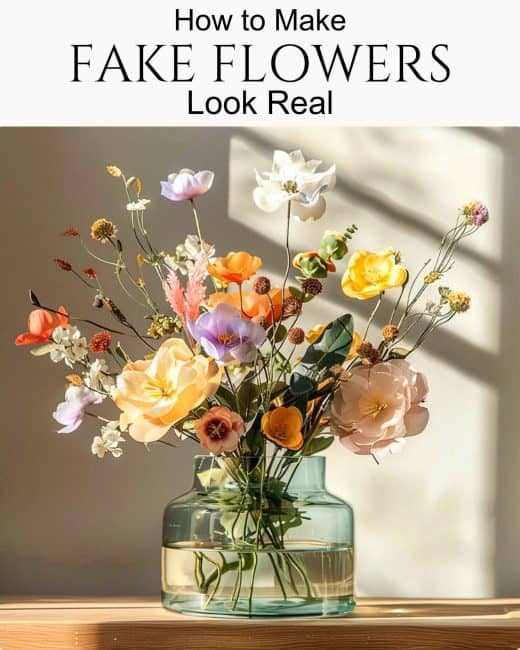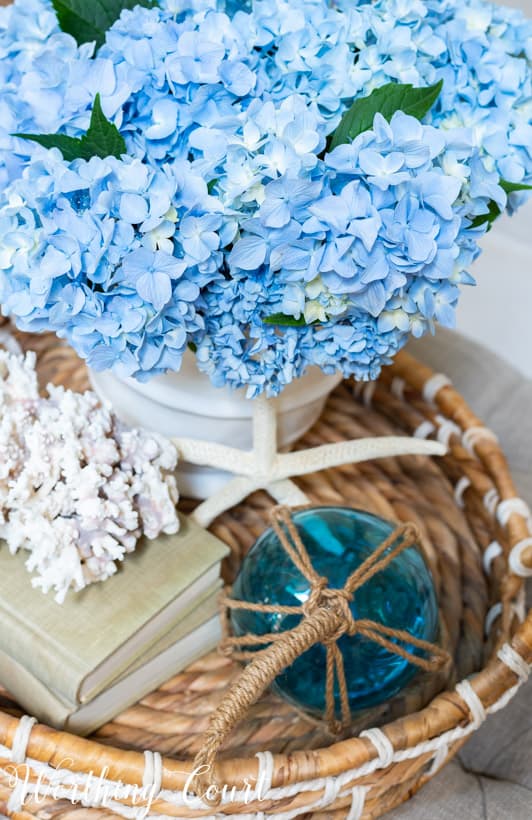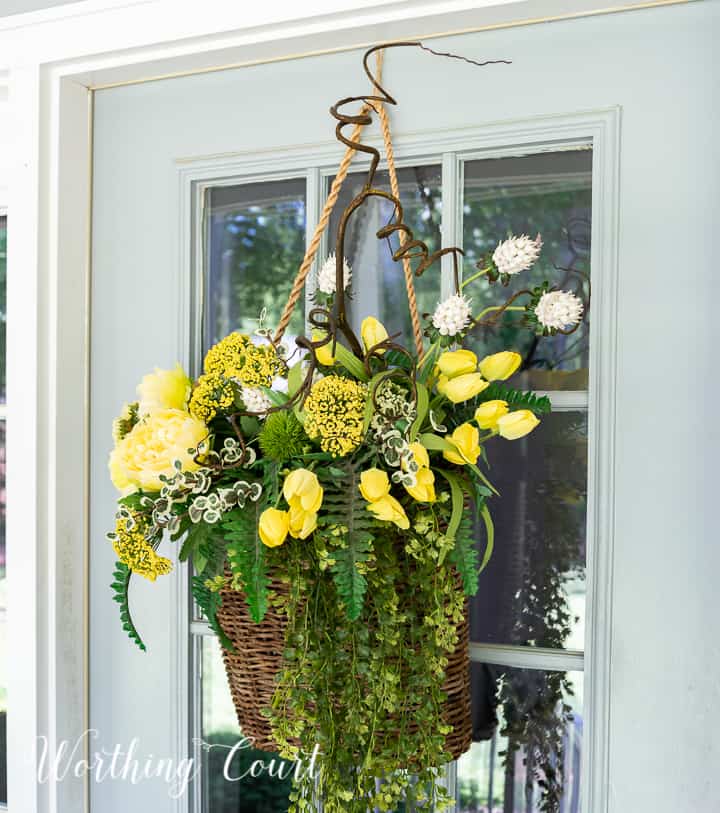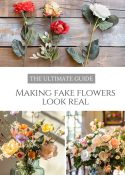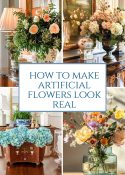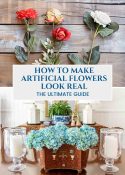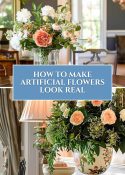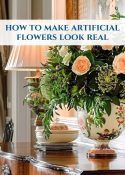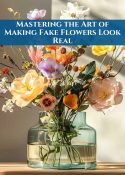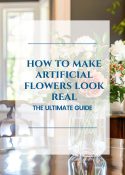Mastering the Art of Making Fake Flowers Look Real
Master the art of making fake flowers look real. With a few simple tricks, you can easily make realistic fake flower arrangements that look just as beautiful as real ones. Learn which type of flower is the best to use, how to treat them in different types of containers, how to prep, care for, and revive them, and more.
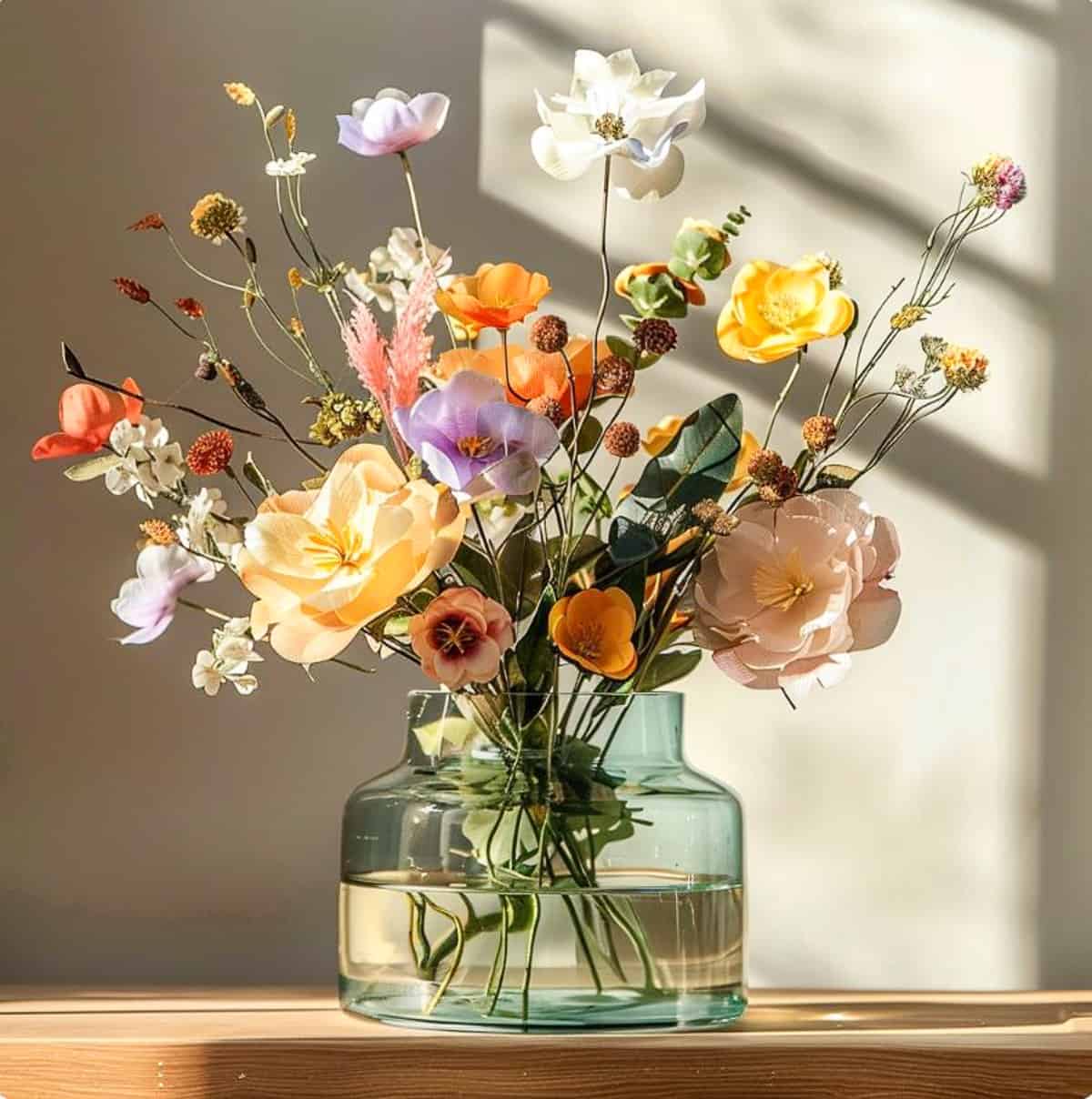
Have you ever been frustrated by the idea of making fake flowers look convincingly real in an arrangement? You are not alone, my friend. But fret not, as I’m here to turn that challenge into a fun adventure.
Say buh-bye to the frustration of less-than-lifelike floral designs and get pumped for the fun of putting together some seriously cool, lifelike flower arrangements.
With this guide, you’ll learn the ins and outs of choosing, prepping, and decorating with faux flowers so masterfully that they’ll fool even the keenest eye. Ready to transform decor in your space with everlasting beauty? Let’s dive in!
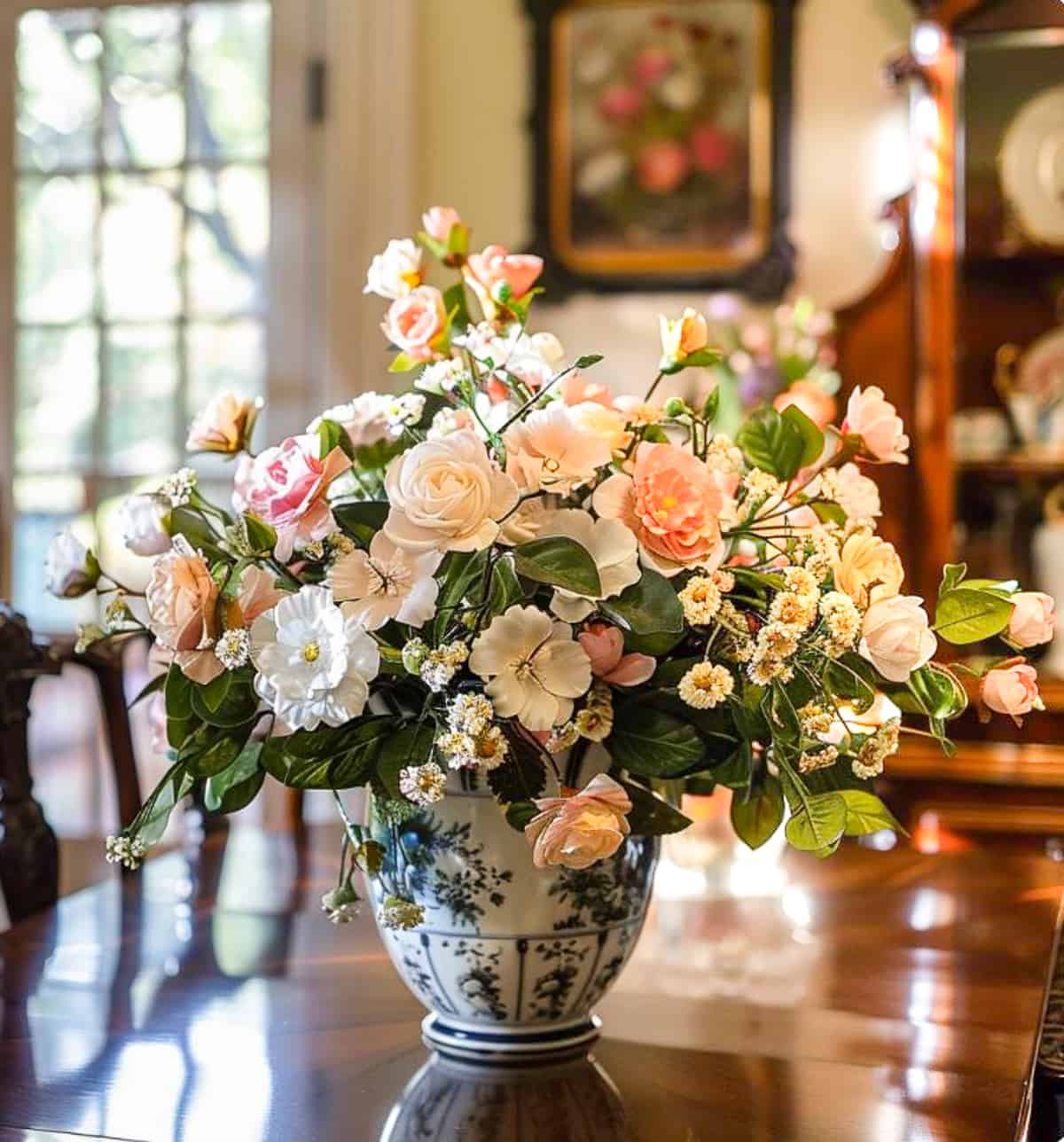
Where to Start
To truly master the art of arranging faux florals, you first need to get up close and personal with the real deal.
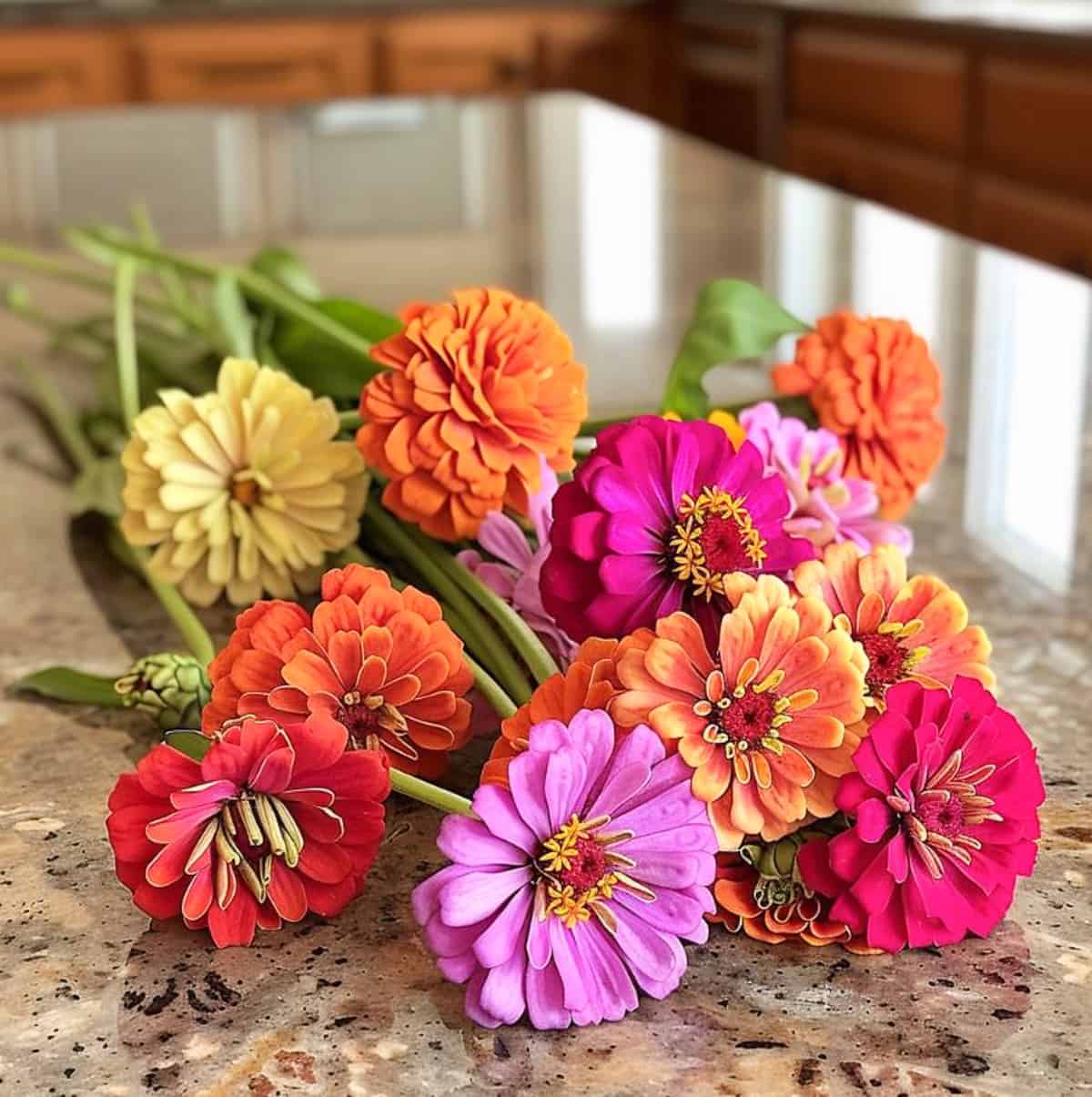
God’s creation is just amazing, isn’t it? Just look at those flowers!
Take the time to closely examine real flowers—the delicate way petals curl at the edges, the burst of colors at the center, and even the imperfections that make them perfect.
Take in the little details, like the texture of the stems and leaves, and the natural, sometimes quirky way they all come together in a bunch.
Pay attention to the petals and buds and how the colors blend from one hue to another.
What is the Best Material for Fake Flowers?
When you’re hunting for the perfect faux florals, silk is considered the cream of the crop and is usually the most expensive. But the world of fake flowers doesn’t end with silk.
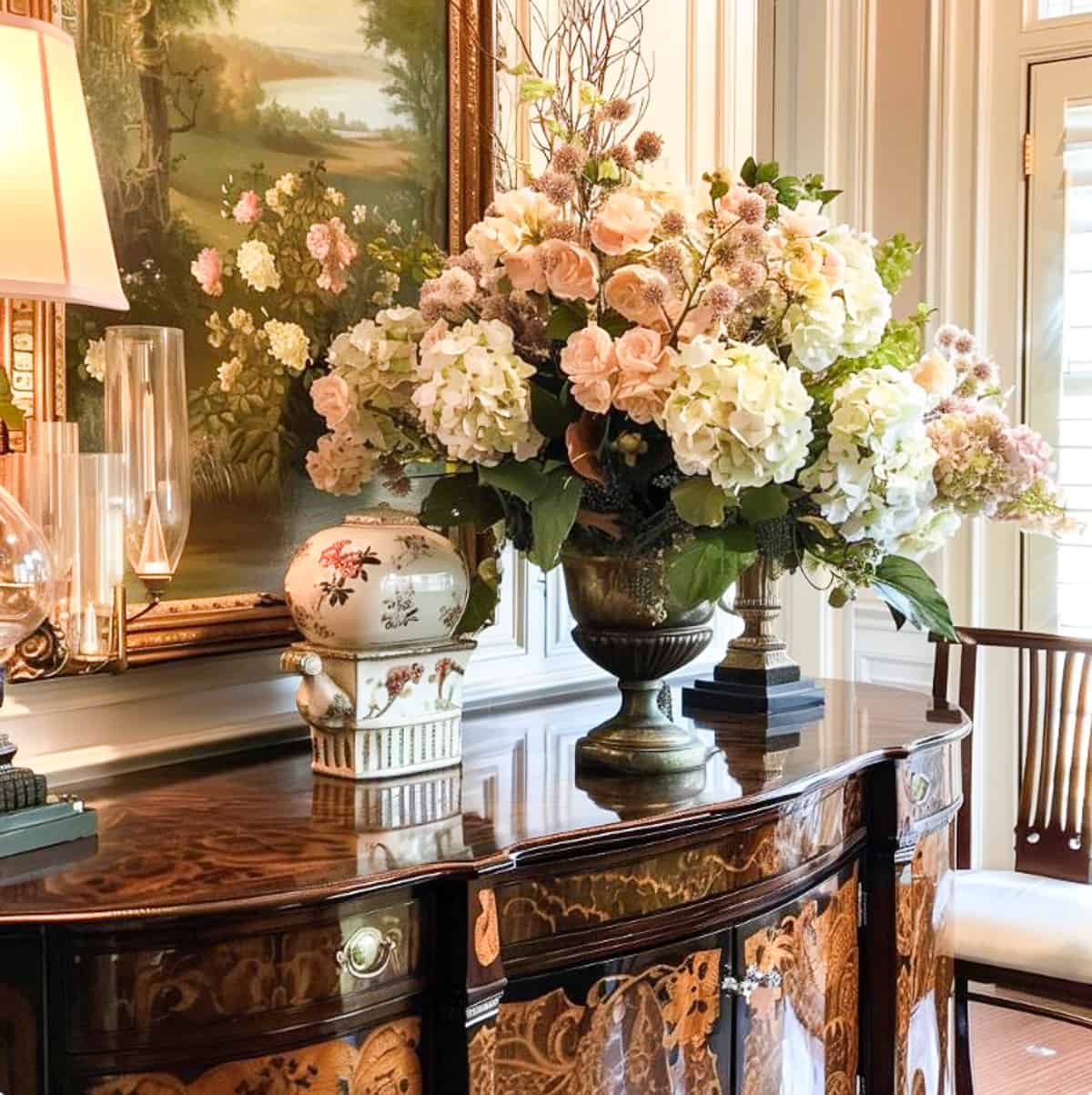
There are many other options to choose from. Each has its own characteristics that affect their appearance and quality.
- Silk: Known for its delicate, realistic appearance and soft texture.
- Latex: Gives a lifelike touch and can include fine details.
- Plastic: Often used for sturdier parts of the flower, like stems and certain petals, for durability.
- Polyester: A versatile and commonly used material that can be textured to look like natural petals.
- Fabric: Varies widely, with some fabrics offering a very authentic look.
- Paper: Crafted for delicate and intricate designs, often found in handcrafted flowers.
- Foam: Lightweight and often used for certain types of flowers that require a specific shape.
- Wax-coated: Adds a unique texture and sheen, resembling dewy petals.
The “realness” of flowers made from silk and polyester often look so close to one another, that it’s hard to tell which is which.
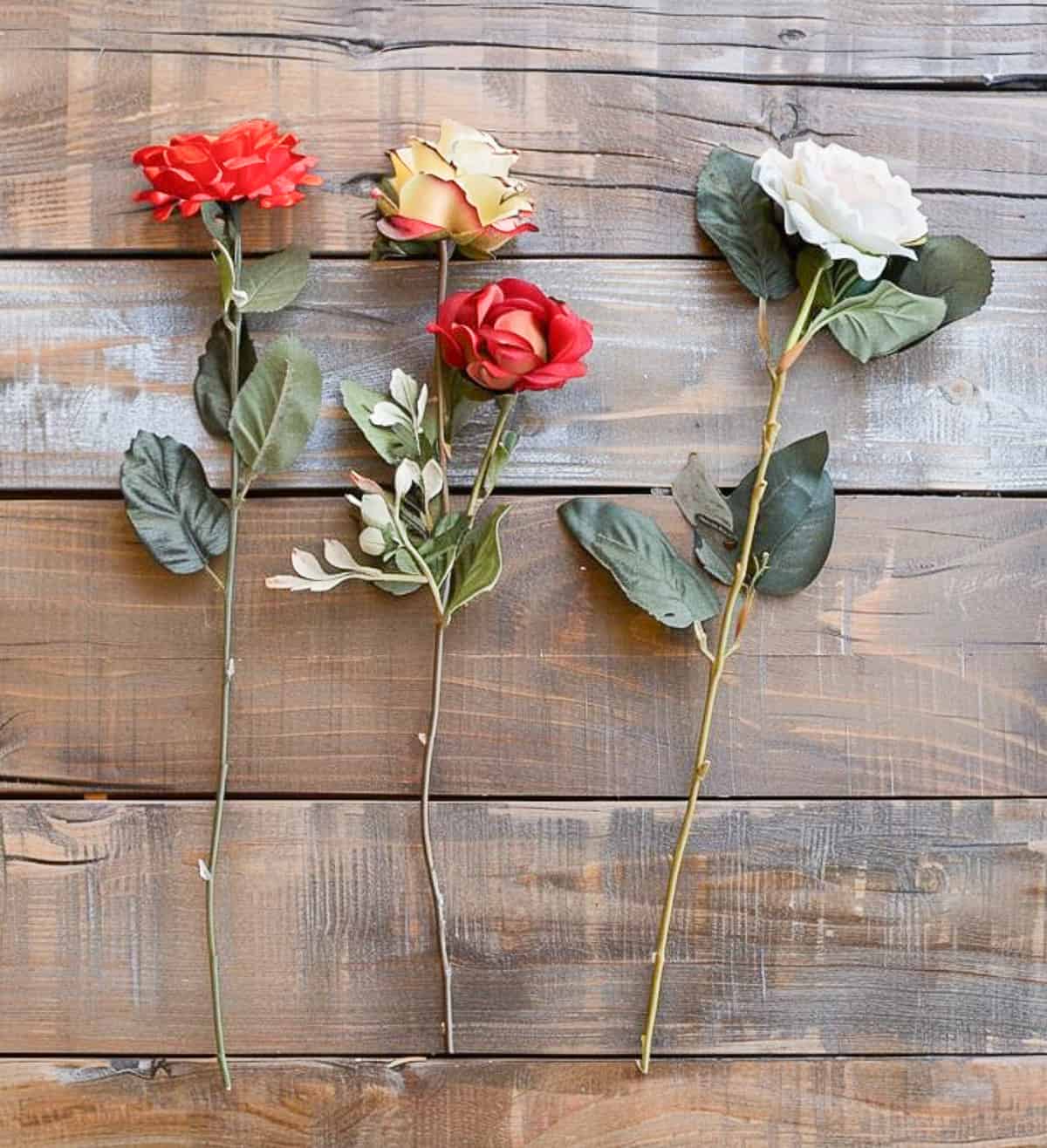
Silk flowers typically have a more delicate, soft texture. The petals may have finer details with a more natural drape resembling how real ones might look in nature.
Polyester flowers might feel slightly sturdier and less delicate. They often will have an almost embossed texture to the leaves and petals.
Plastic is usually the least realistic material for fake flowers, as the petals and leaves can appear too shiny, rigid, and thick, lacking the subtle textures and variations of real blooms.
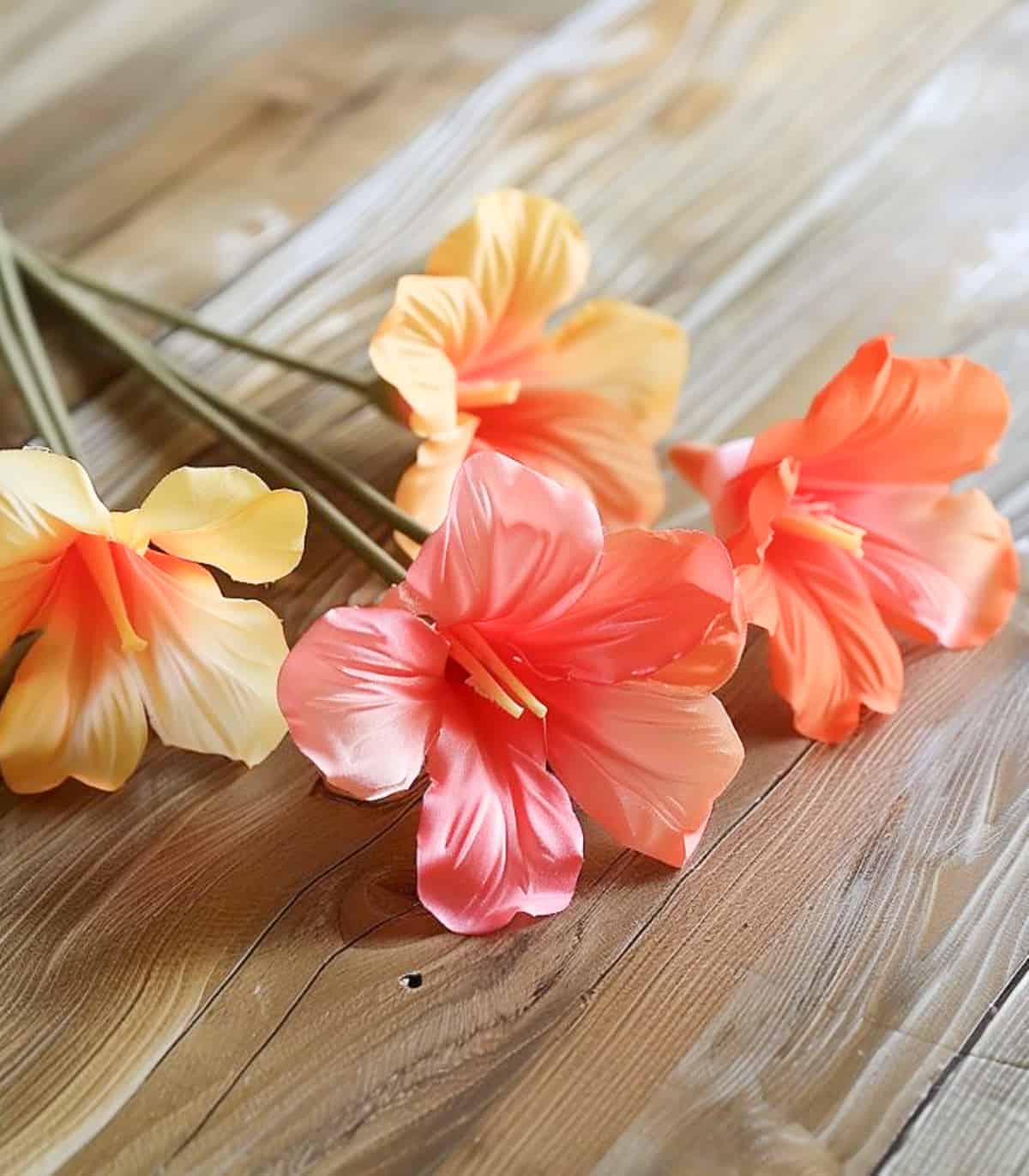
But in the end, the best material depends on the intended use, desired appearance, and durability requirements.
TIP: Make sure that any stems that you purchase are bendable and shapeable.
Types of Containers to Use for Fake Flowers
Choosing the right container for your faux flowers is like picking the perfect frame for a painting—it should enhance the beauty without stealing the show.
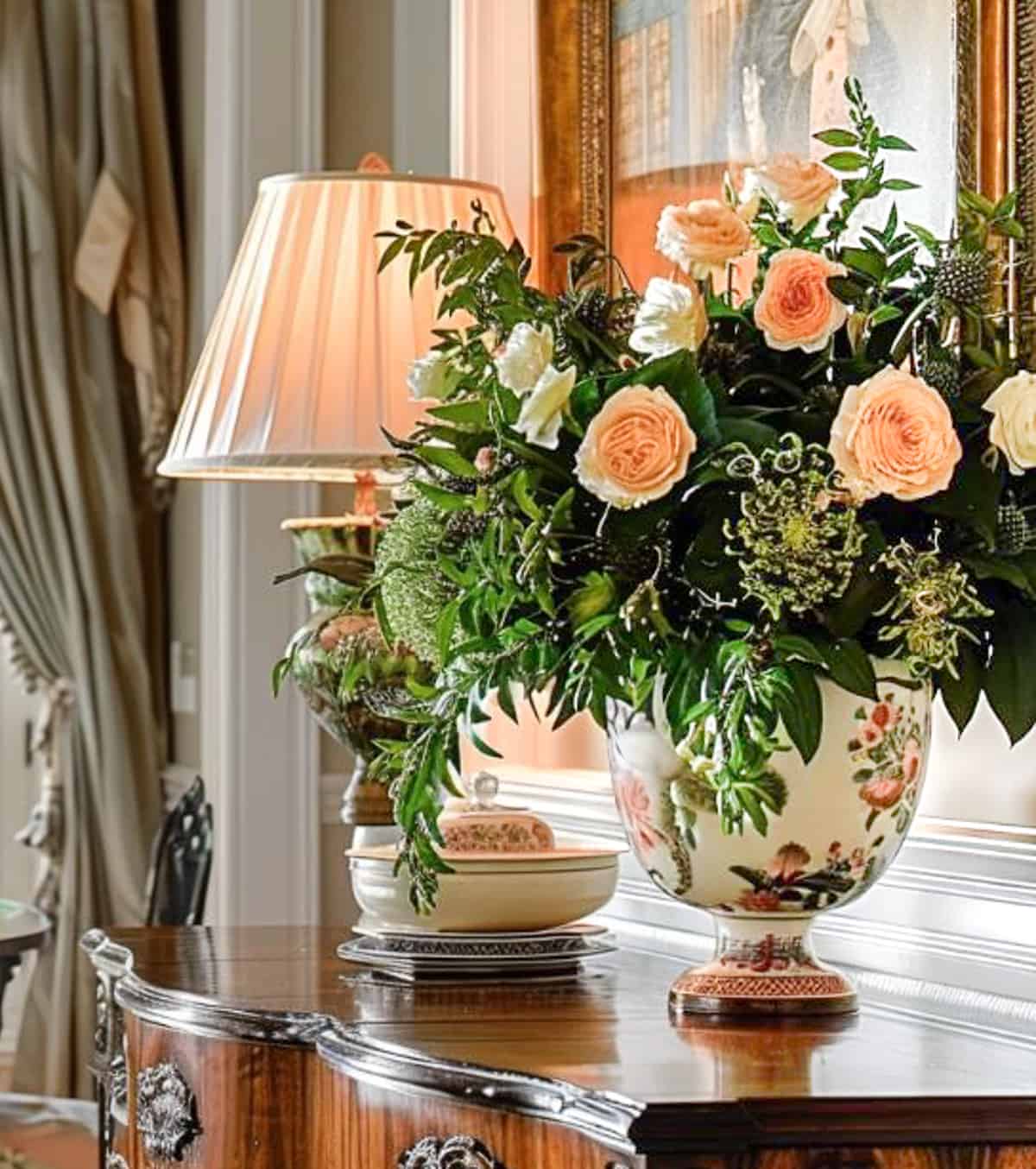
Think about the vibe you’re going for. A sleek glass vase can add a touch of elegance, allowing the stems to be part of the display.
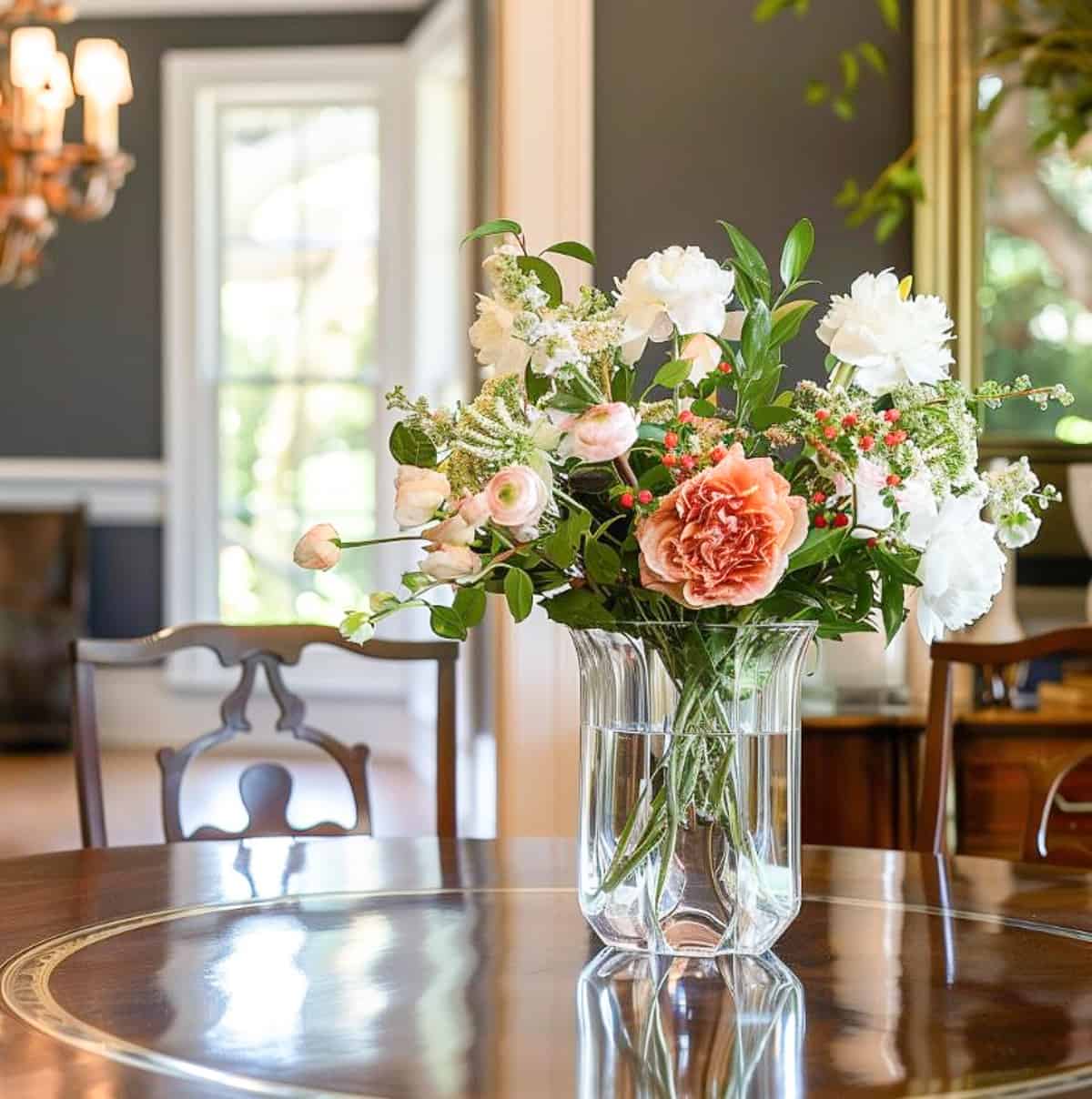
But if you’re aiming for a less stark appearance, a ceramic vase may be your go-to.
I also use decorative painted cachepots for arrangements, especially for a centerpiece. One of my favorites is one filled with a glorious arm-full of faux hydrangeas!
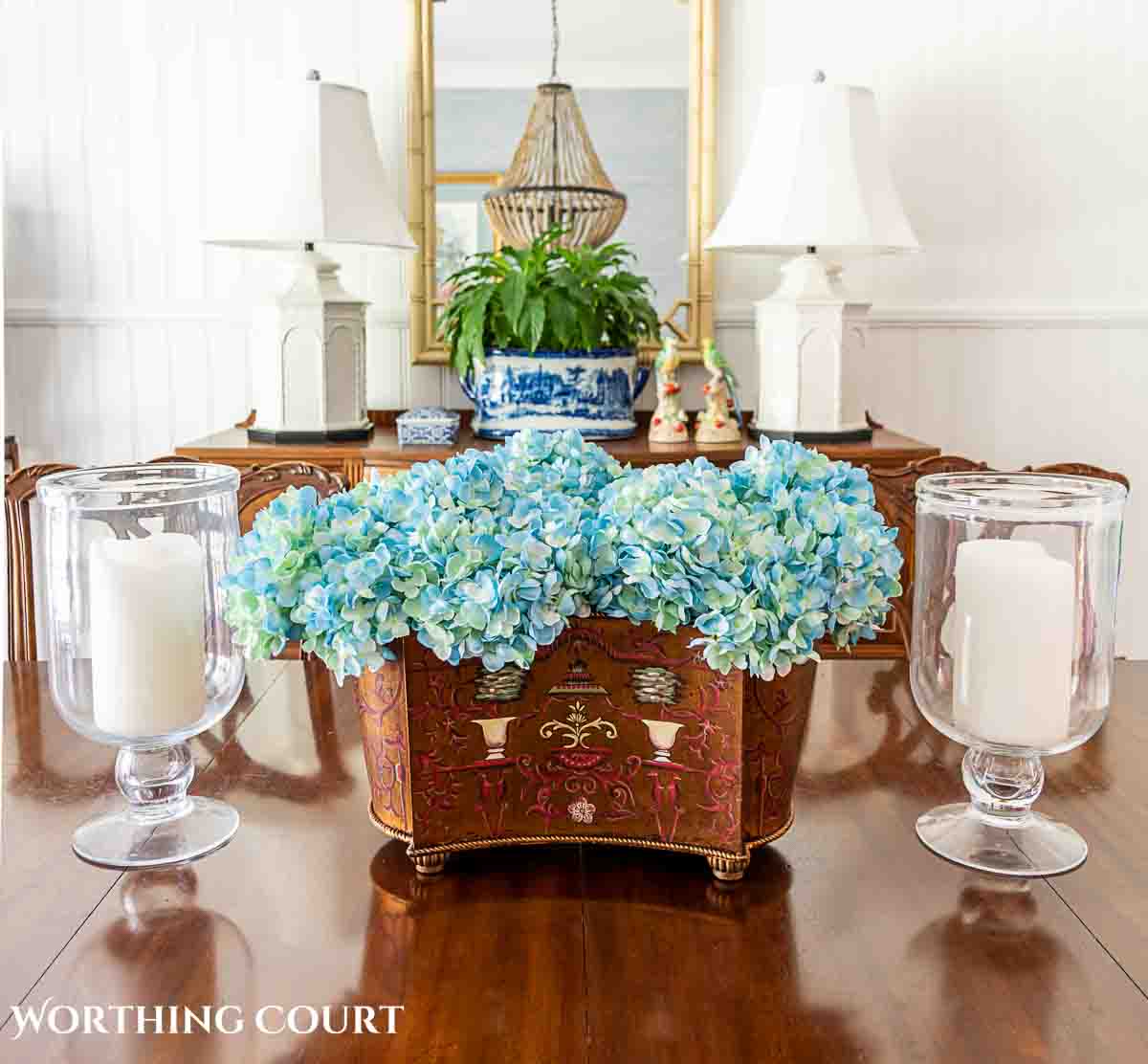
When selecting a container that isn’t clear glass, consider the contrast and harmony between the container and the flowers.
A multi-colored container can be striking, but it’s usually best paired with simpler, solid-colored flowers to avoid a clashing, busy look.
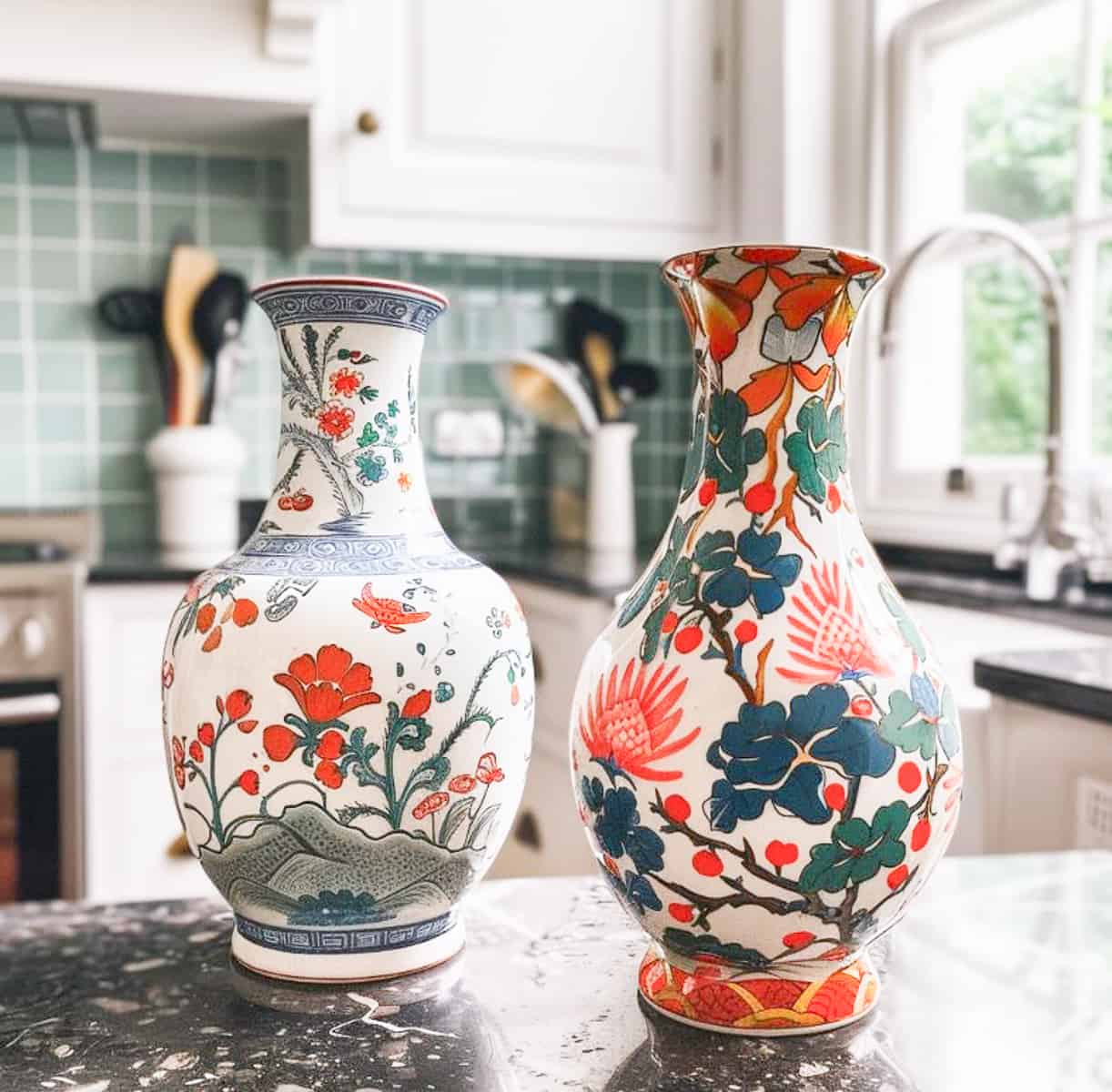
Conversely, a simple, single-colored container can beautifully complement and enhance the vibrancy of multi-colored blooms.
Think outside of the box – ginger jars make great flower vases too. Set the lid to the side for an extra decorative touch.
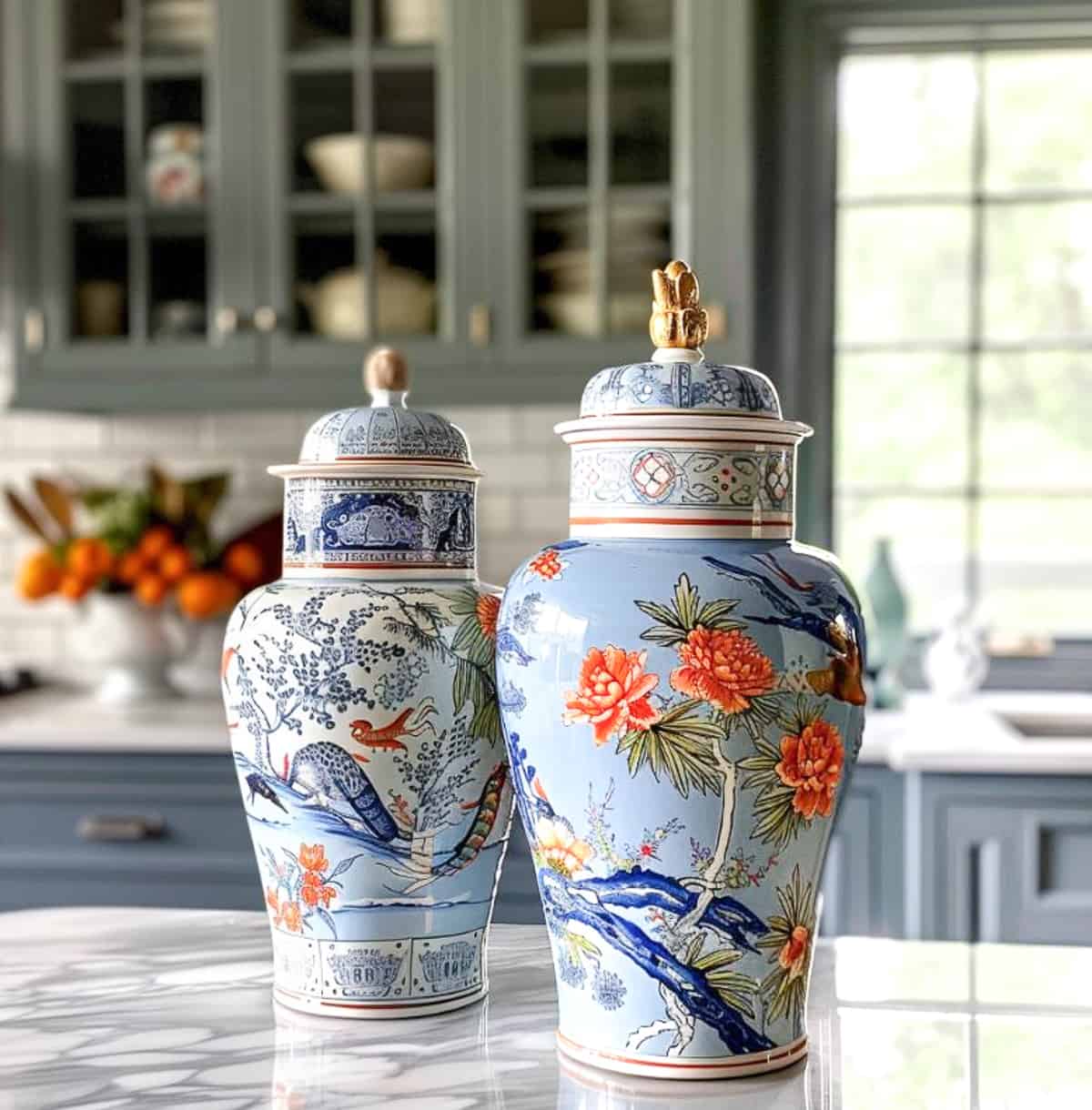
The key is balance; you want the flowers and the container to complement, not compete with, each other.
Keep in mind that the container is more than just a holder; it’s a critical part of your floral arrangement’s overall look and feel.
TIP: To make fake flowers look real in a glass vase, add a bit of water.
Prep the Stems and Blooms
Let’s get into the nitty-gritty of prepping those gorgeous blossoms.
Your first decision is to determine the best length for your stems in the vessel in which they’ll be displayed.
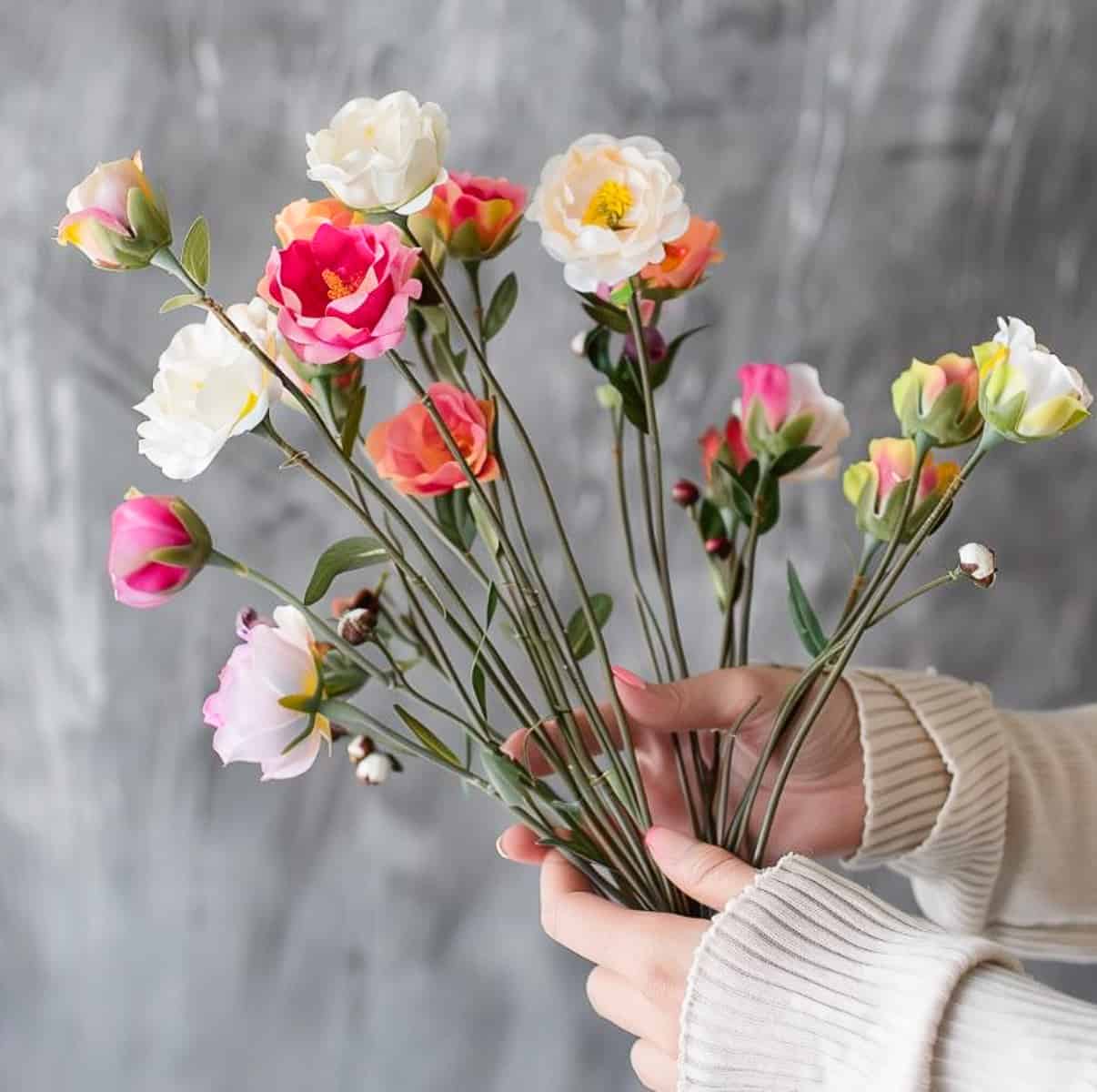
As a rule of thumb, flower stems should be about one and a half to two times the height of the vessel to look their best. This proportion helps to create a balanced and visually appealing arrangement. But of course, that can vary depending on the look that you’re after.
If the stems are too long, you’ll need to either bend the ends or cut them off with a pair of wire cutters.
When I need to cut them, I’ve found the best way to determine the length is to hold one stem beside my container with the amount of stem that I want revealed above the top, then lop off the excess length from the bottom.
Next is to get the faux blooms themselves looking natural. Try holding a stem upside down and spinning it between your hands. The spinning motion will cause the buds to open more.
If the petals or leaves are flattened or wrinkled, gently reshape them with your hands. You can also use a hair dryer on low, to warm the material slightly, which makes them more pliable. More about reviving mashed flowers below.
The #1 Secret for Long Stems
The #1 secret for getting long faux flower stems (think forsythia, cherry tree stems, etc.) to look realistic is to think about how they would naturally reach for the sun or droop under their own weight in real life and then mimic that.
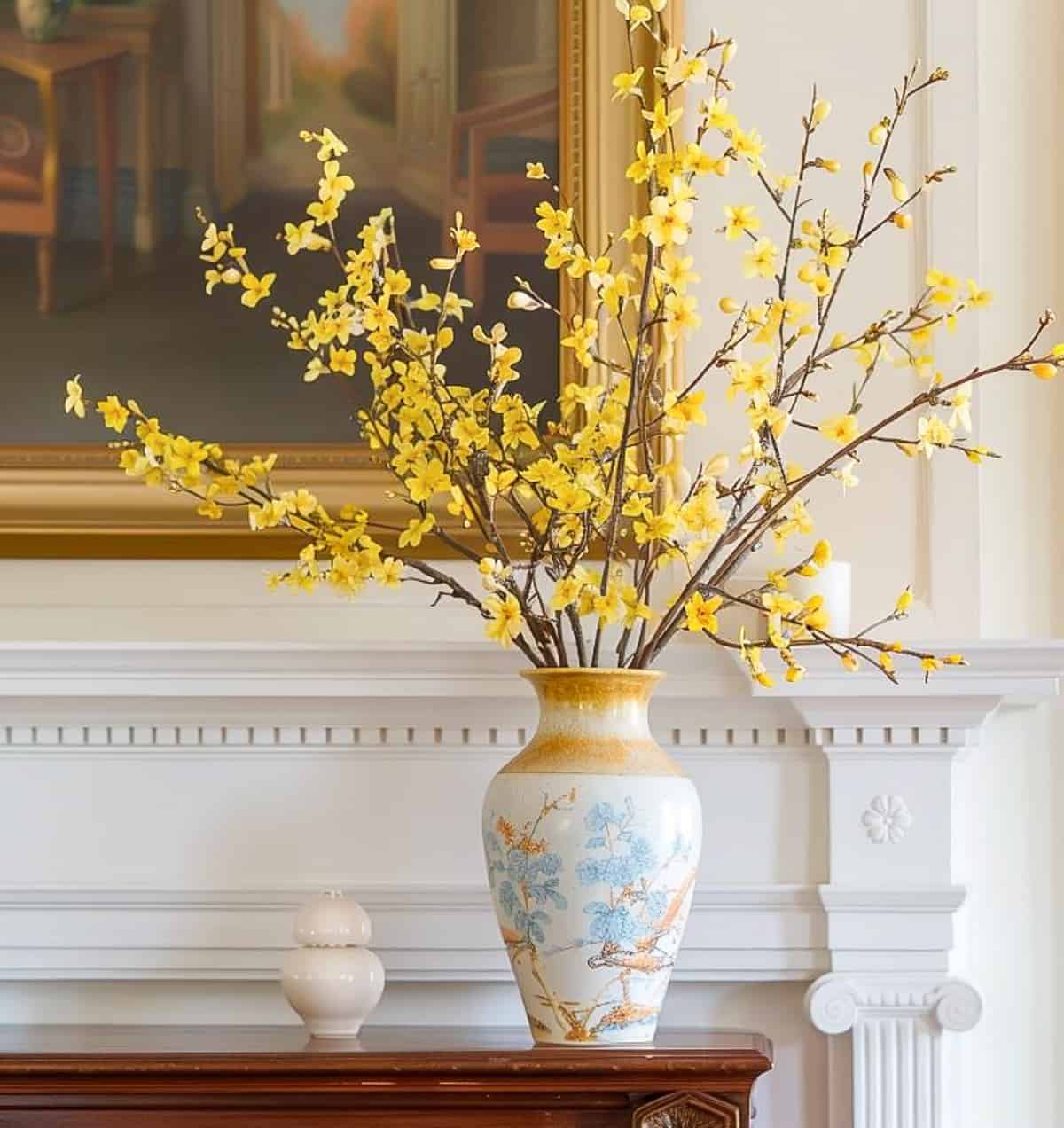
That’s why it’s important to purchase faux stems with bendable wire – so that they are bendable and shapeable.
And this also references the very first point, which is to closely examine real flowers so that you’ll have a good feel for the tweaks you need to make to yours.
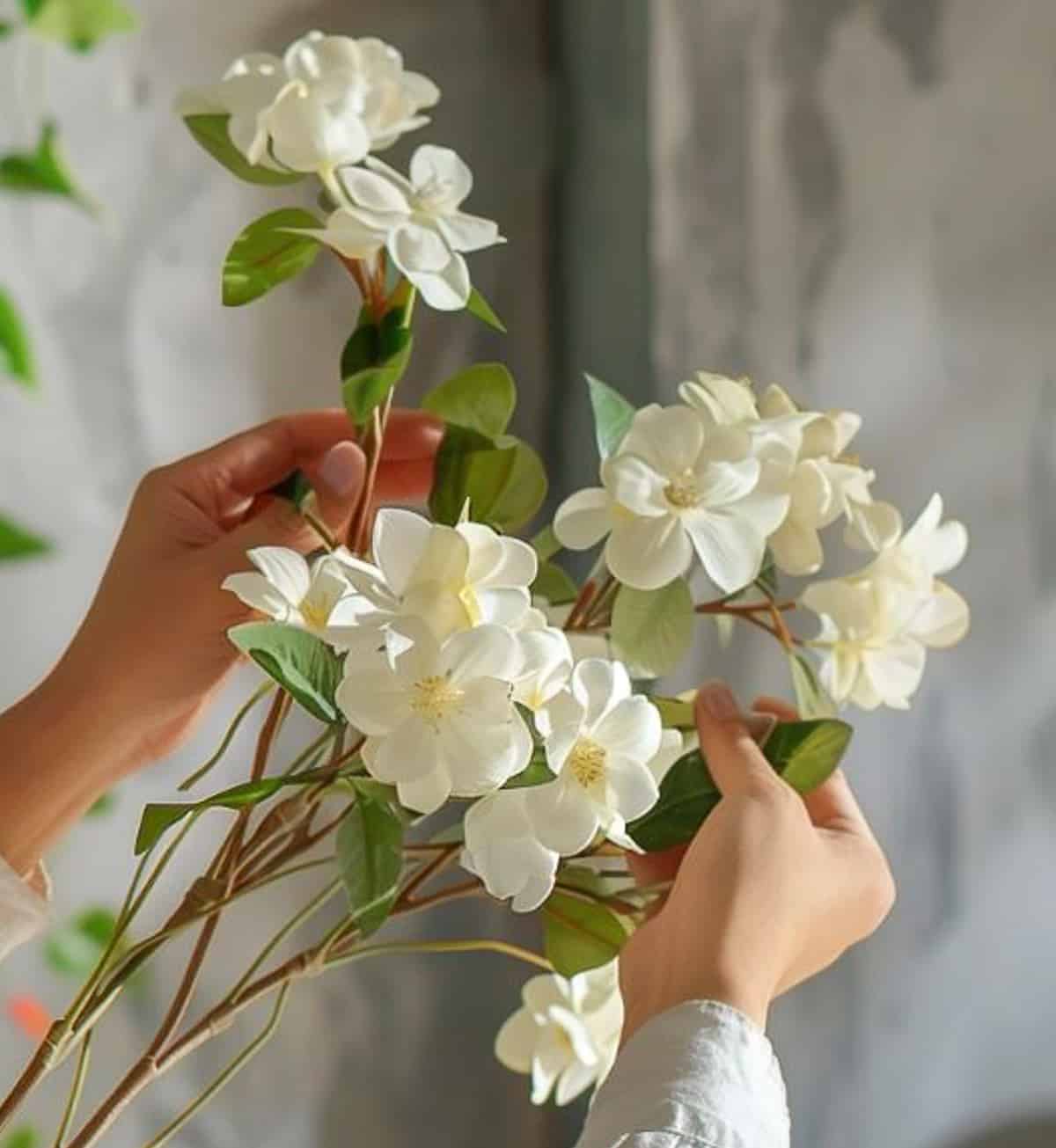
So give them a little bend here and a twist there to get them looking all casual and natural, as if they grew that way. It’s all about making them fit into their new home in a way that looks effortless and oh-so-real.
How to Care for and Clean Artificial Flowers
With a little bit of easy maintenance, you can keep your faux florals looking fab for ages.
No harsh sunbathing for these beauties; keep them out of direct sunlight to prevent fading.
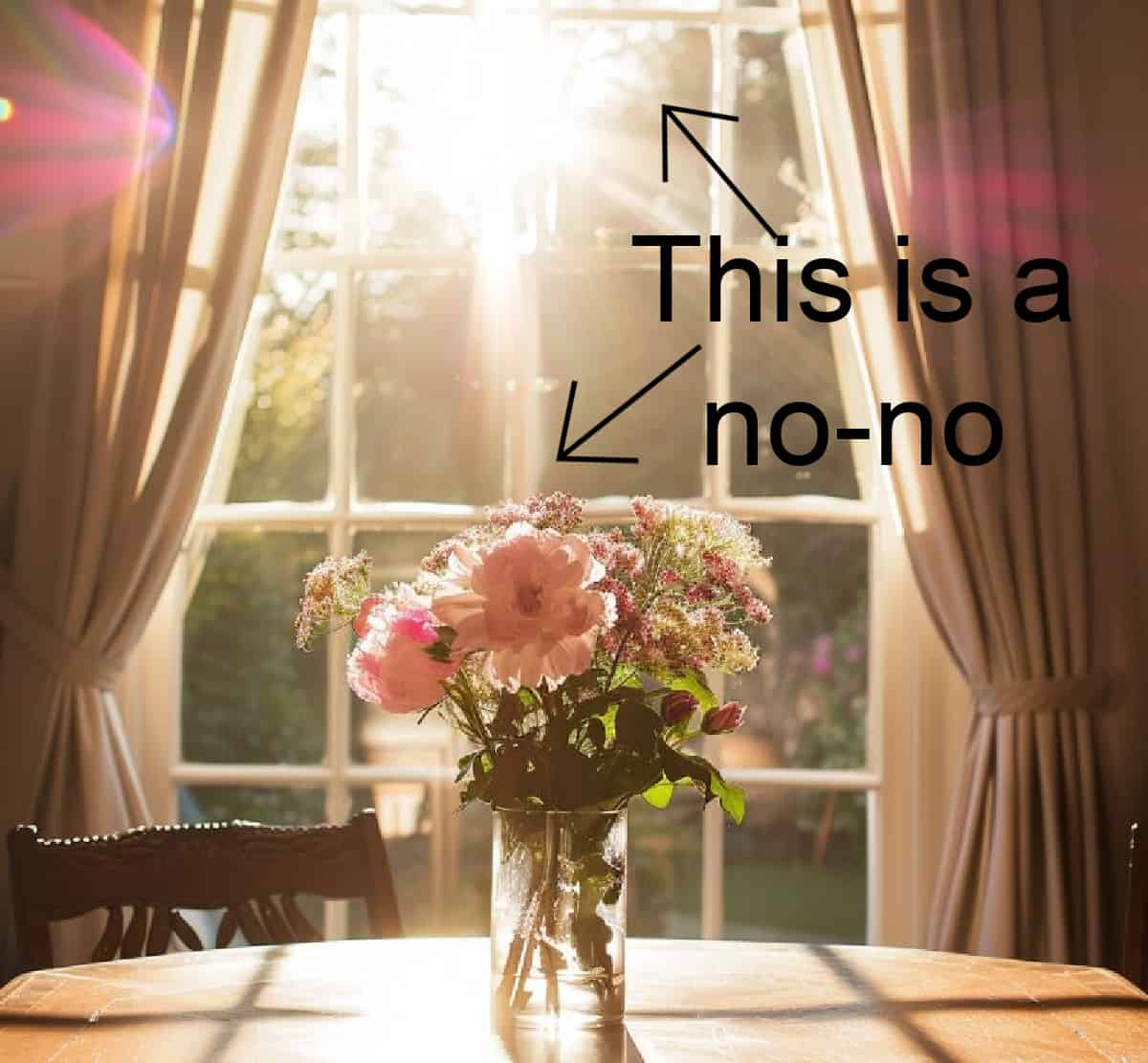
Dust them off gently with a soft brush or a hairdryer on a cool setting to avoid any dust bunny build-up.
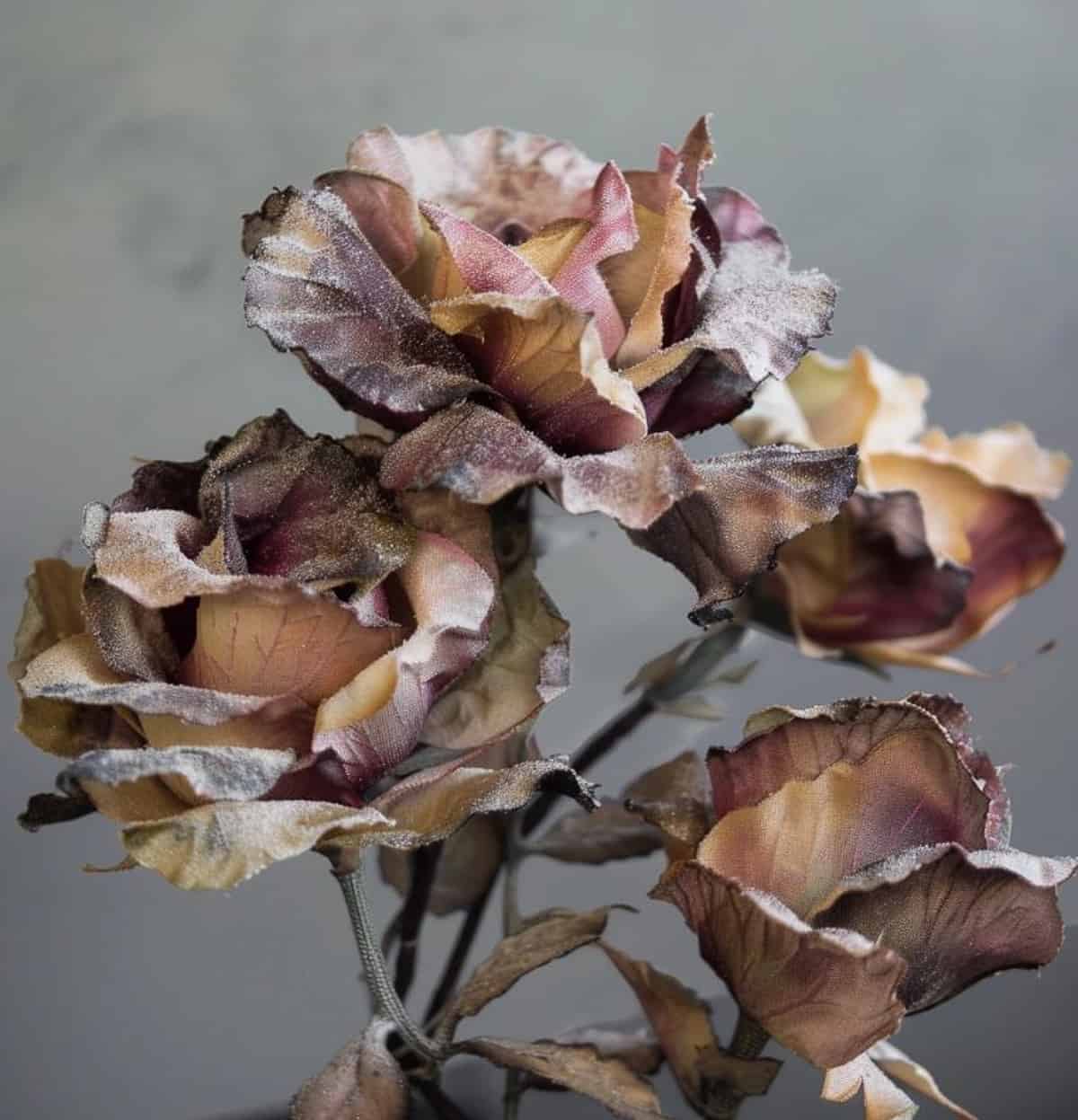
If the dust is heavy, a gentle wipe with a damp cloth should do the trick. I have actually rinsed mine under a gentle stream of water, but do that at your own risk!
With these simple care tips, your fake flowers will keep their fresh, just-picked look for years to come!
Where to Find Quality Artificial Flowers and Greenery
When searching for the most realistic flowers, do you kind of feel like this lady – not knowing what to look for in a sea of choices? Goodness, that’s a lot of flowers!
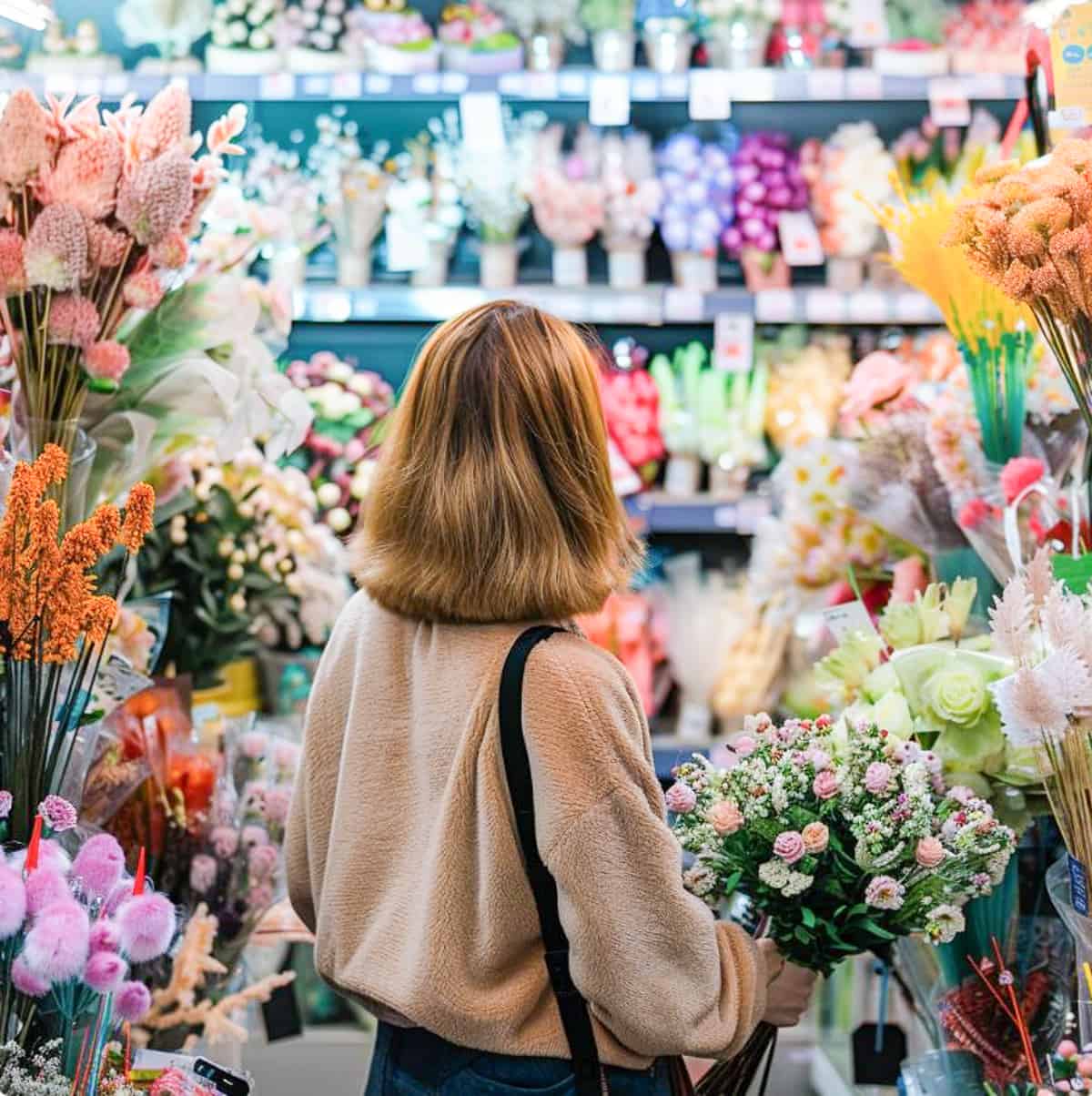
Finding faux florals is easy, but finding realistic, quality faux florals can be a different story. This is one product that is definitely a reflection of the old adage, “you get what you pay for”.
Here’s a list of sources that I recommend and a dollar amount rating, sorted with prices averaging from the highest to the lowest:
- Silks Are Forever – Silks Are Forever offers high-end, lifelike flowers made from silk in vibrant colors that will never wither or fade. $$$$
- Nearly Natural – Renowned for their lifelike artificial plants and flowers, Nearly Natural is a go-to source for premium faux botanicals of all kinds that have been designed by horticulturists to ensure realism. Many of their products are also available on Amazon. $$ – $$$$
- Afloral – Afloral offers a wide variety of artificial flowers, plants, and related decor items. They place a high emphasis on quality and realism in their products, $$$
- Prestige Botanicals -Priding themselves on customer relationships, Prestige Botanicals says it is their company’s mission to provide meticulously crafted artificial flowers and greenery focusing on realism and luxury. $$$
- Jeffrey Surles Designs – This is a new-to-me resource that I’m excited to order from. I’ve been following him on Instagram for quite a while and am very impressed with the realism of the products he shares. $$ – $$$
- Hobby Lobby – Hobby Lobby has long been known for selling quality florals. In fact, I purchase most of my stems from them. For the best prices, be sure to wait for when they are on sale, which occurs every other week. $$
- Amazon – I also purchase many florals and greenery stems from Amazon, where there is a large selection of retailers. Since you can’t see them in person, I recommend only purchasing from retailers with reviews of 4 stars or more. $$
How to Store Faux Flowers
With proper storage, your flowers can stay looking fabulous for years.
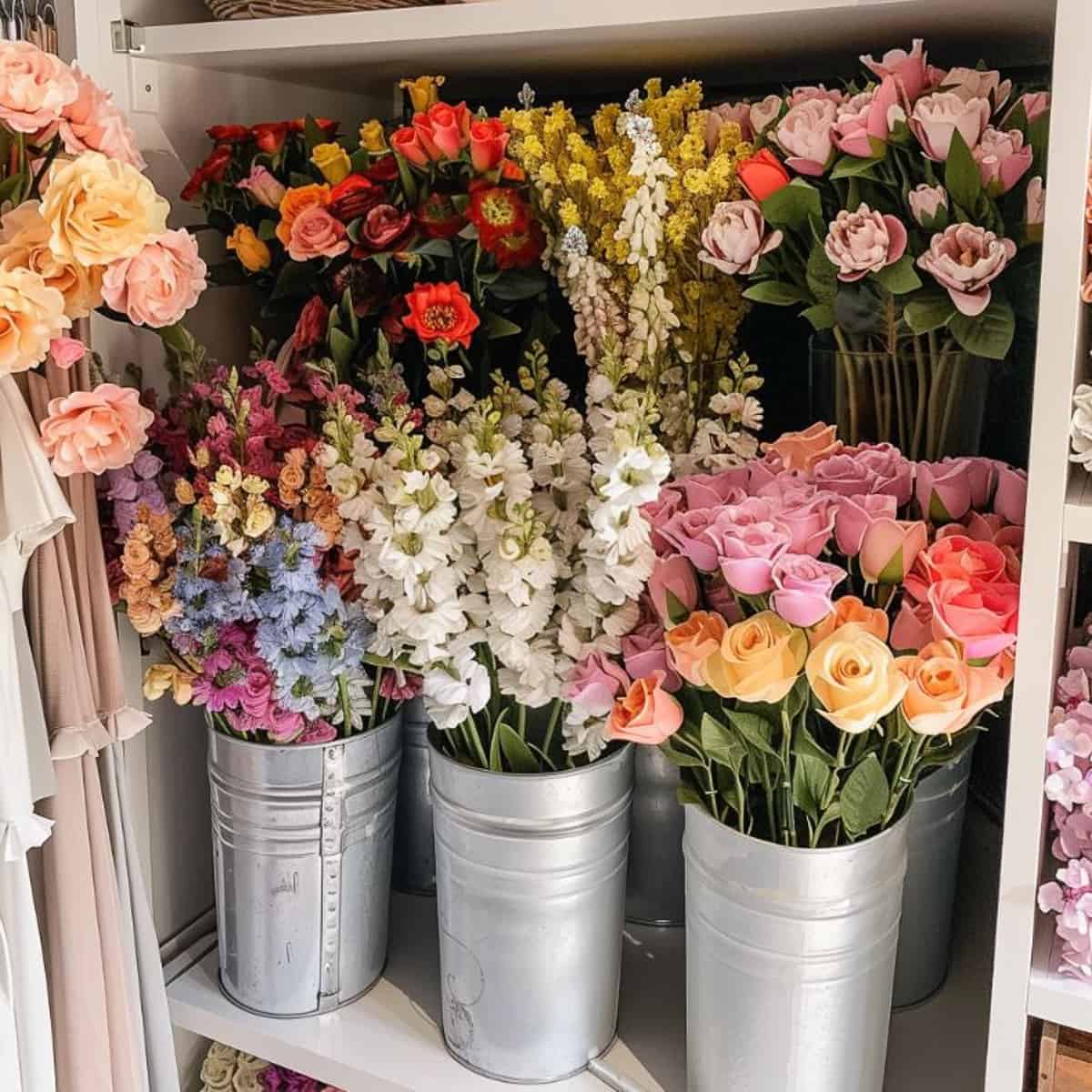
Be sure to find a dry spot away from direct sunlight to avoid any color fading.
It is recommended to store them in a cool place, however, I do store mine in my attic, where it gets hot during the summer, and have had no problem whatsoever. But just like rinsing them with water, do this at your own risk too.
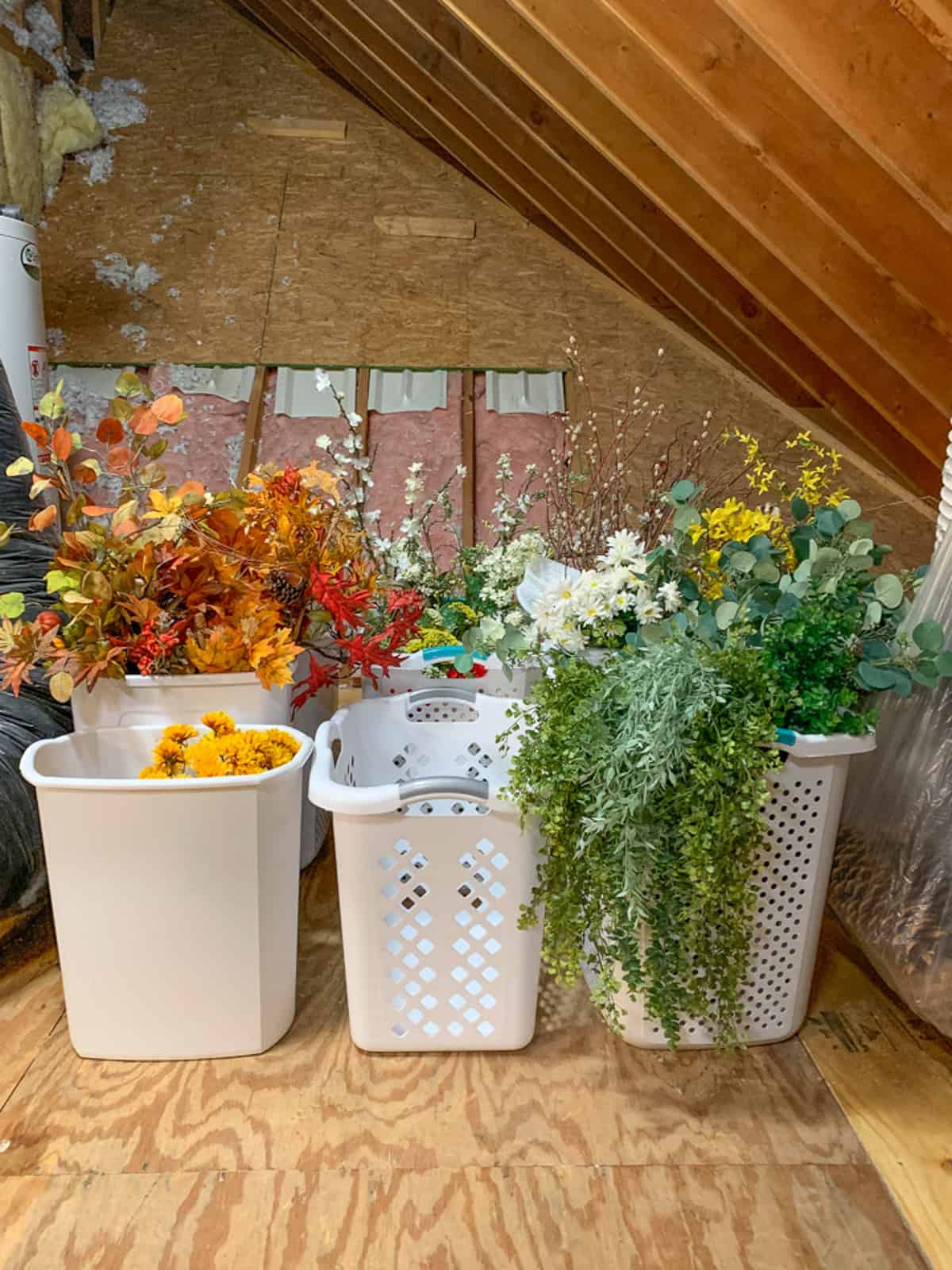
Gently clean your flowers before storing to remove any dust. If available, use the original packaging or a soft, breathable cover to prevent any squishing or crinkling.
If you’re stacking them, go easy on the pressure to avoid crushing. Crushing inevitably happens though, so read on for how to revive them.
How Do You Revive Tired Fake Flowers?
Squishing and crushing will inevitably happen to your beautiful faux botanical stems.
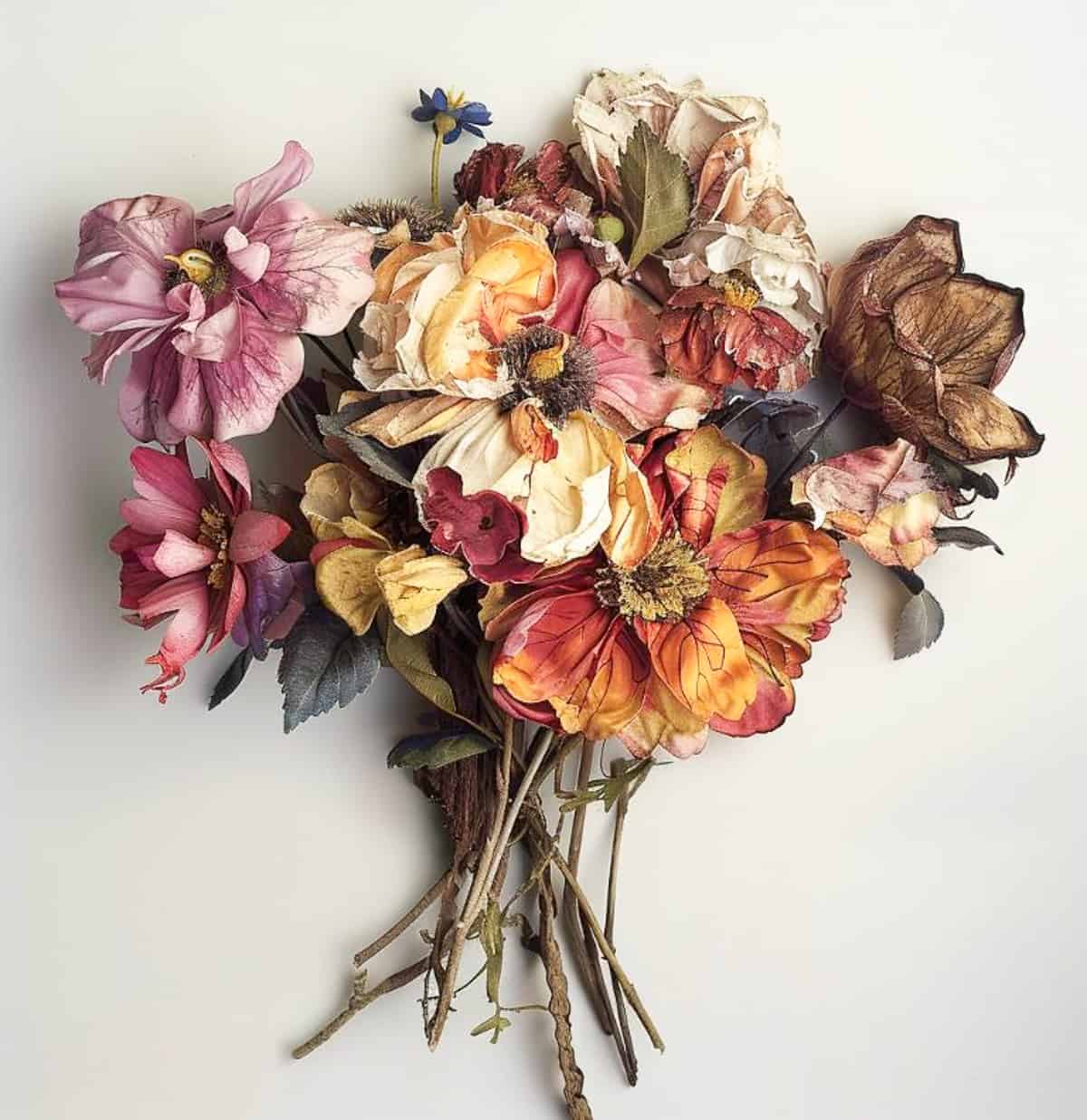
To revive and fluff them again, gently reshape the petals and leaves with your hands.
You can also use a hairdryer on a low, cool setting to warm the material slightly, making it more pliable for reshaping.
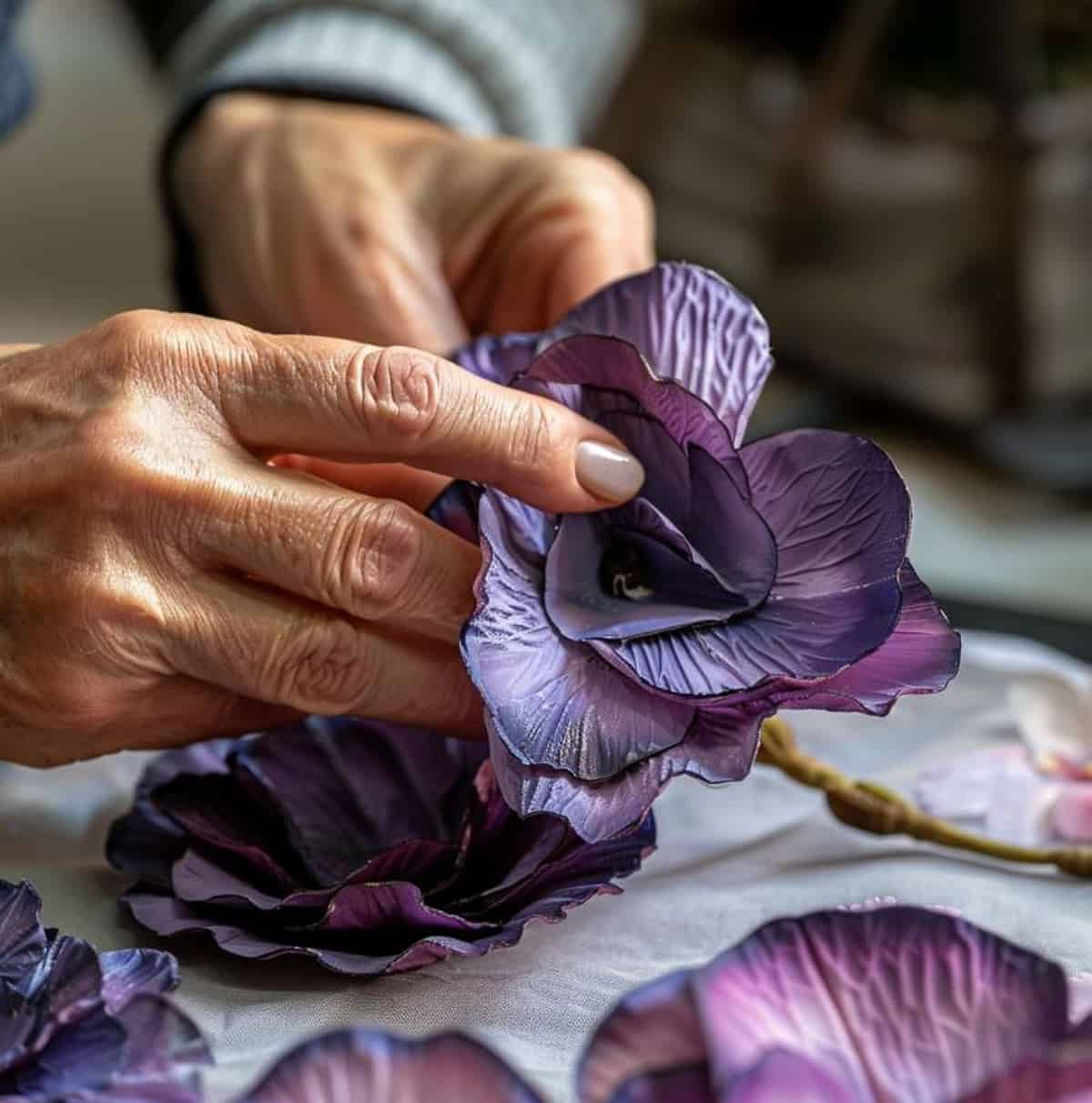
If the flowers are very wrinkled, a light steam can help, but be careful not to wet or overheat the material, especially if it’s silk.
After reshaping, let the flowers cool and settle into their new form.
What to Avoid
For the most realistic flower stems, you’ll want to avoid these things:

- Avoid flowers flowers with overly bright, unnatural colors.
- Flowers made with plastic have a shiny finish and usually look cheap and unrealistic
- Don’t cluster the blooms too tightly in a vase. Real flowers need space to breathe and don’t grow that way.
- Avoid uniformity and too much perfection. In nature, blooms are naturally imperfect.
- Don’t neglect cleaning and dusting your artificial arrangements. Dirty flowers quickly lose their lifelike appeal.
- While the natural scent of flowers can be heavenly, avoid using scented candles or room fresheners that are supposed the mimic the smell of certain flowers. In my opinion, they haven’t perfected them yet.
And there you have it, your ultimate cheat sheet to making those faux florals fool everyone!
The beauty of artificial flowers is their longevity, but their realism lies in your hands. So, fluff those petals, tweak those stems, and arrange them with intention.
Whether you’re making a centerpiece or creating a little vignette, your faux blooms are now ready to steal the spotlight, no watering can required.
